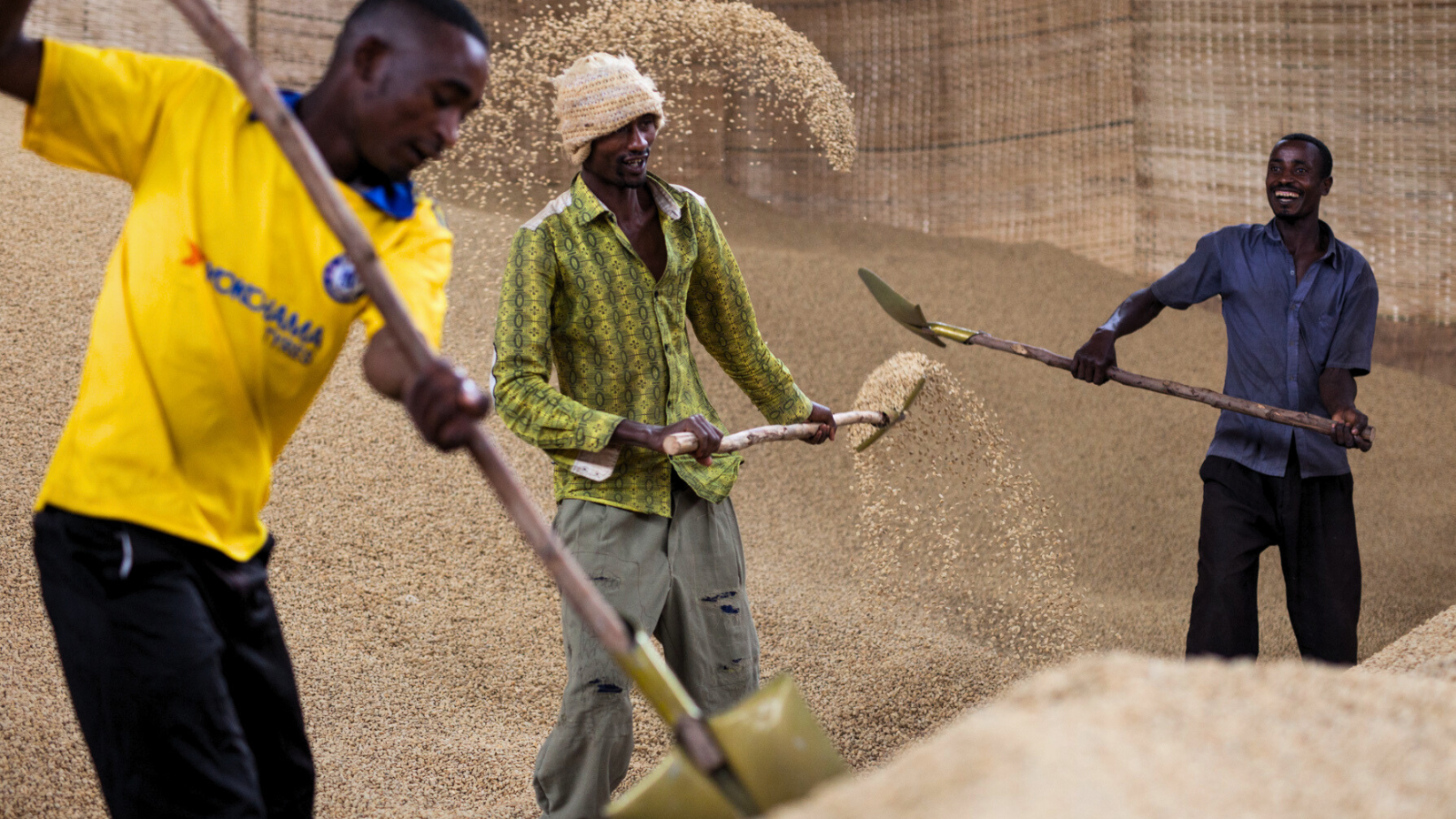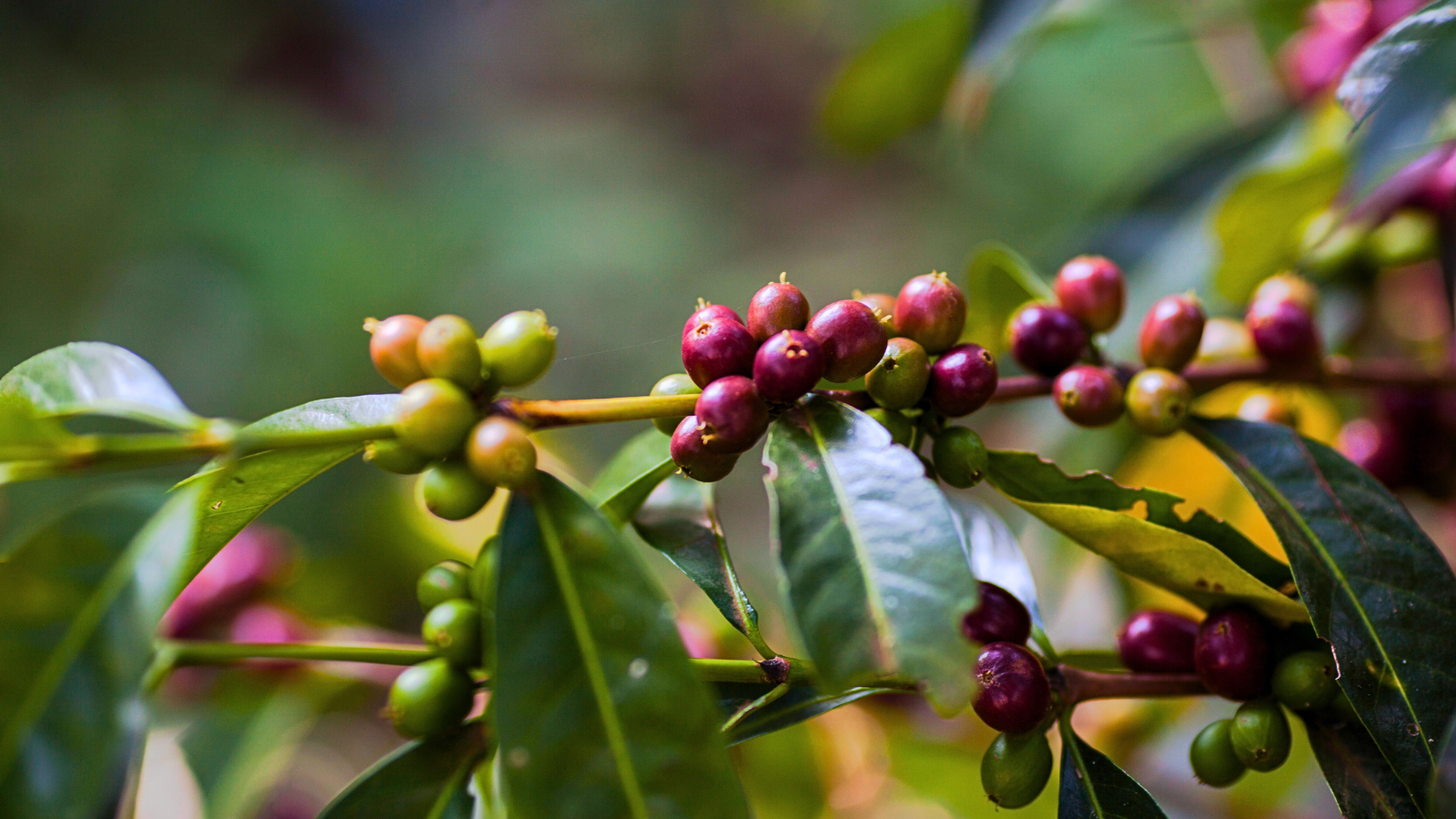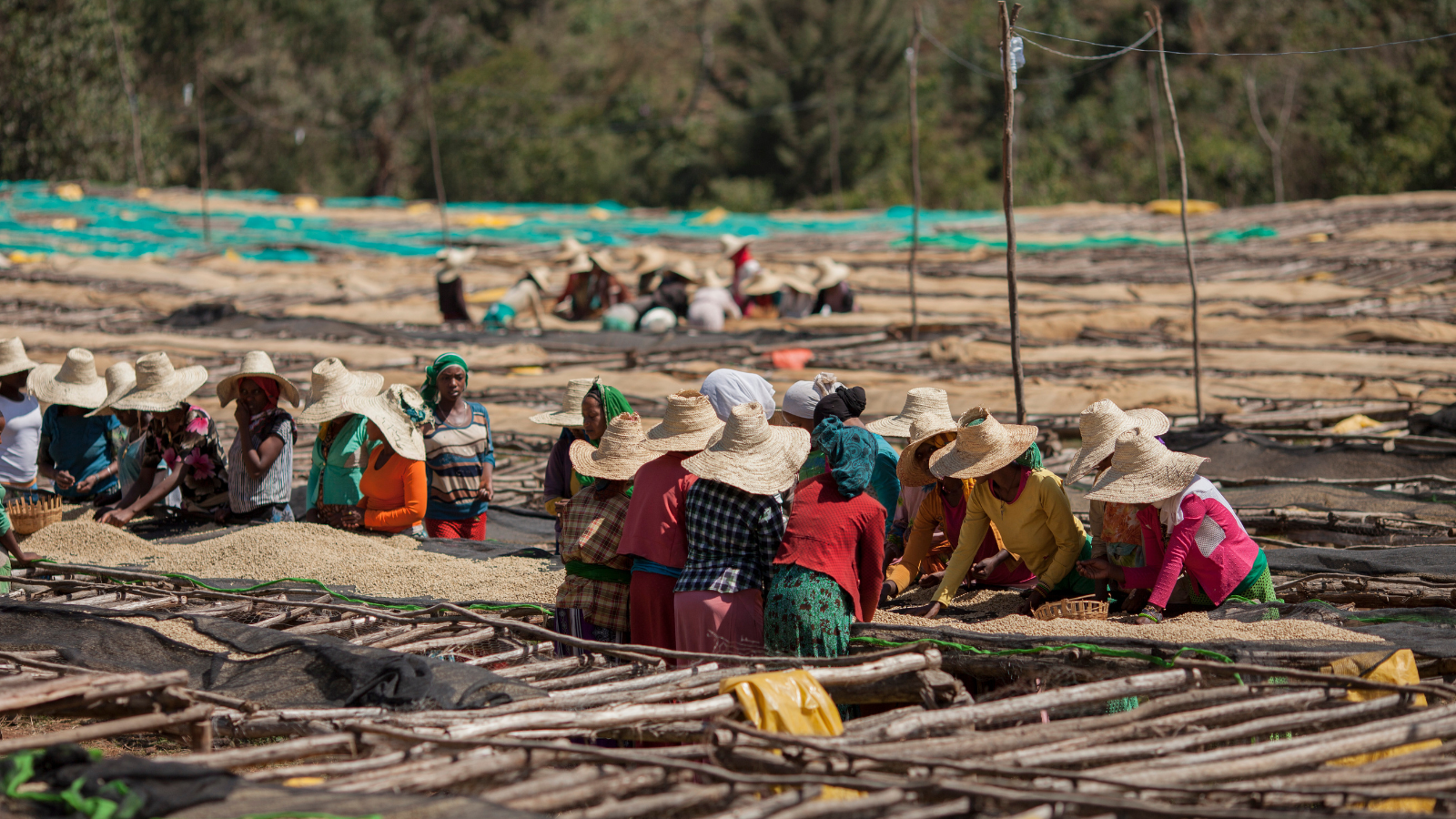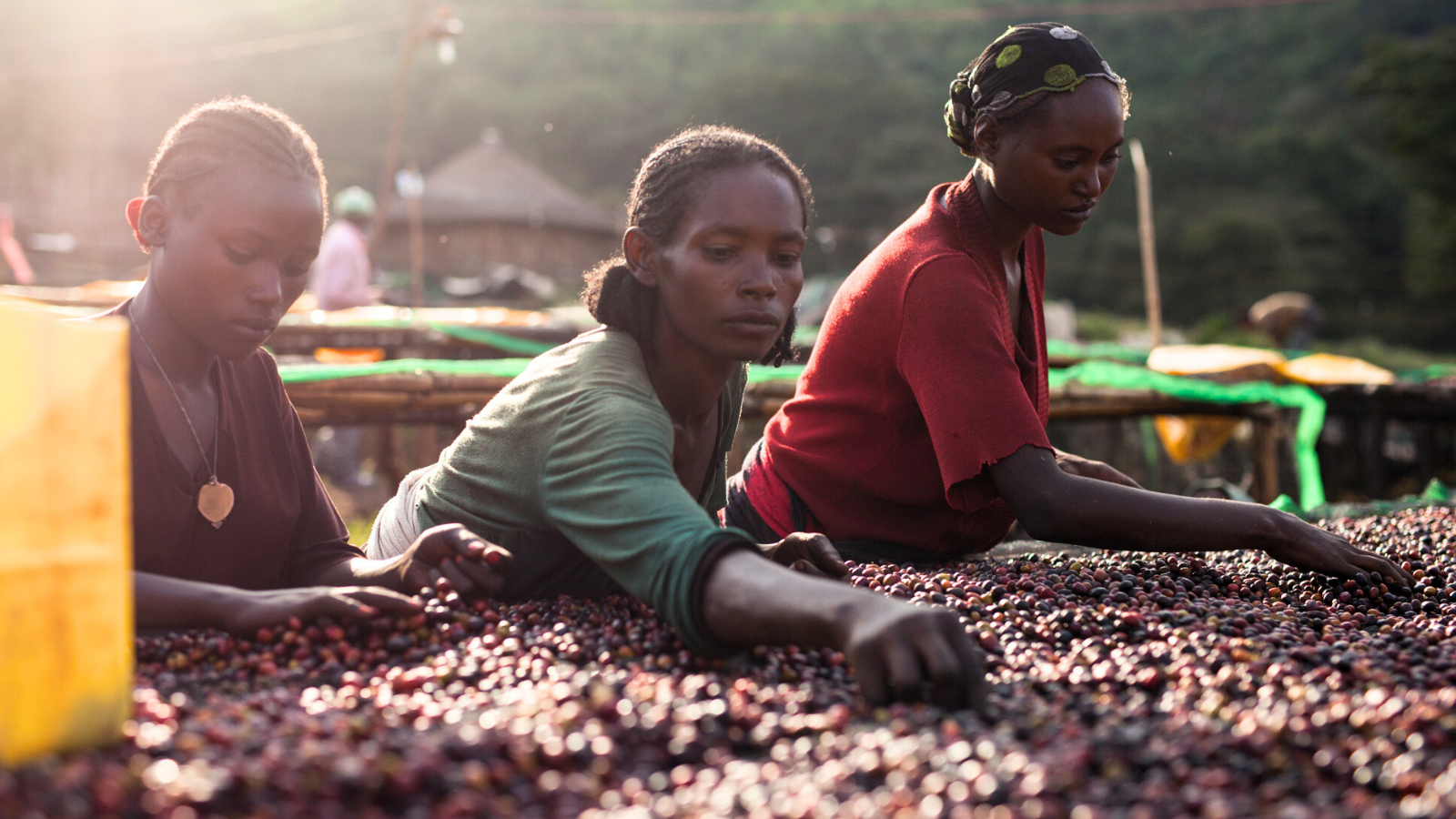Ethiopian coffee is cherished by coffee roasters and coffee drinkers across the globe, and for good reason! Ethiopia is widely recognized as the birthplace of coffee. The storied coffee origin even has its own coffee legends and mythology. While Ethiopia only produces 3-4% of the world’s coffee supply, it has an outsized reputation. The variety and character of the coffee that comes from Ethiopia is astounding. Ethiopia is famed for its “fruit bombs” and for expressing a wide assortment of distinctive floral notes and sweet flavors. Every year, coffee roasters seek out Ethiopian green coffee beans to help them win competitions and delight customers.

Pushing coffee along in washed processing at a wet mill in Ethiopia
The History of Ethiopian Coffee
According to legend, an Ethiopian goat herder named Kaldi discovered coffee in the 9th century. He noticed his goats dancing and displaying high energy levels after eating the red berries from an unknown shrub, and upon trying the fruits himself, he experienced an energy boost like never before.
His discovery reached local monks, who brewed a beverage that helped them stay awake throughout long nights of prayer. Thus began the history of coffee as a stimulating drink to encourage productivity.
Coffea arabica is native to Ethiopia and has always grown wildly throughout the forests there. However, it wasn’t until the 1500s that people in Ethiopia started to cultivate the crop seriously. Coffee plants soon spread to Yemen and made their way to Italy via Mediterranean trade, as well as Central and Eastern Europe via the Ottomans.
Coffee is as important to Ethiopia’s economy as it is to Ethiopian culture. The Oromo people of the Guji region have their own origin story for the discovery of coffee; that’s how deeply woven the crop is within their traditions.
Instead of Kaldi the goatherder, the Oromo sky god Waaqa brought forth a new plant from the earth with his tears that were shed over the wrongful death of a loyal servant. From as early as the 10th century, coffee has been present in Oromo culture as a special plant that provided energy when the beans were mixed with fats and eaten on long journeys.
People in Ethiopia have been consistently drinking coffee longer than anyone else on the planet. Ethiopian coffee ceremonies are elaborate rituals that encapsulate the journey of a coffee bean from unroasted coffee to brewed beverage. Green coffee is roasted over a fire, freshly ground, and brewed in an ornate jebena pot before being served to a group of friends, family, or community members to enjoy in a moment of togetherness.

Shoveling dried Ethiopian coffee
Ethiopia Coffee Production
Ethiopia’s number one export is coffee, which makes up over one-third of the country’s export revenue. Around 25% of the population depends on the coffee value chain, and it’s the backbone of Ethiopia’s economy and culture.
Although the country faces research, innovation, and climate change challenges, Ethiopia’s total annual production volume is forecasted to keep increasing yearly, according to the USDA. Around 8.2 million bags of 100% Arabica coffee are produced annually; approximately 60% of that is exported. Local consumption accounts for about 40% of the total volume.
An interesting trend that has recently emerged is the popularity of roadside coffee stalls that serve coffee in the traditional manner of the Ethiopian coffee ceremony. However, due to the small size and fluid manner of the shops, they can sell coffee at more competitive prices than commercial shops, thus expanding their demand over the past 15 years.
Ethiopia’s soaring altitudes are the perfect setting for producing high-quality Arabica coffee. Ethiopian producers traditionally employ one of three growing methods: forest coffees, garden coffees, and estate coffees.
Forest coffee from Ethiopia grows wild in the forest, mostly under shade and among other native plants. The rich soil, nurtured by humus that falls from the trees, empowers wild Ethiopian coffee trees to thrive naturally. Organic by default (but not necessarily certified as such), little intervention is necessary to produce ripe cherries that are harvested by locals.
Garden coffee, on the other hand, grows on small plots of land, often smaller than a hectare. The amount of coffee is measured in the number of trees rather than area size. Ancient landrace varieties dominate the smallholder coffee gardens that are also generally organic, tended by farmers who intercrop food crops to maximize the potential of this region’s fertile soil. Garden coffee is the most common farming method in Ethiopia.
A small percentage of coffee in Ethiopia grows on large plantations and estates. Because a majority of the coffee from Ethiopia comes from smallholders, they often lack their own infrastructure to process coffee at the farm level. Some choose to deliver cherries to wet mills and washing stations owned by cooperatives or private companies, while others process coffee at home with the natural method.
Establishing the Ethiopian Commodity Exchange (ECX) in 2008 was a turning point for the conditions of the coffee industry by addressing inequalities and political imbalances. The goal was to help farmers earn higher prices with faster financial turnaround while rewarding quality where it was due. One method the ECX employed was to semi-anonymize coffee lots on the cupping table, grading them based on quality and region rather than producer reputation.
However, the anonymization was a setback in traceability, particularly for smallholders who sold coffee directly to the ECX instead of via a certified cooperative. In 2017, the Ethiopian Coffee & Tea Development and Marketing Authority revised the ECX, allowing all Ethiopian coffees to be sold with full traceability. Farmers could now apply for their own export licenses and have more control over the supply chain.
Interestingly, it is illegal to sell export-quality coffee locally in Ethiopia. To maximize foreign exchange, the Government of Ethiopia actively inspects coffee warehouses and issues penalties for hoarding coffee in hopes of higher prices in the future.

Forest-grown coffee cherries ripening in Ethiopia
Common Ethiopia Green Coffee Varieties
Around six to ten thousand varieties still grow wild among the mountainous forests of Ethiopia. Due to a lack of genetic testing, most coffees from Ethiopia are given the generic categorizations of “heirloom” or “landrace” as umbrella terms.
The difference between heirloom and landrace, although they are often used interchangeably, is the degree of human intervention in the development of the plant. Heirloom and landrace trees are both associated with a specific region, but heirlooms have been traditionally cultivated and handed down throughout generations. On the other hand, landraces have adapted naturally to local areas and are shaped by natural selection, often featuring a broader genetic diversity.
As for the common Ethiopian green coffee varieties that have been studied and identified, Gesha coffee is the most distinguished one that comes to mind. This variety originated in the Gesha forest of Ethiopia and was first cultivated at the Lyamungu Coffee Research Station in Tanzania. Although the coffee is sometimes referred to as “Geisha” due to a British transliteration of the region’s name, Gesha is more commonly used when the coffee is from Ethiopia. In contrast, Geisha is used when the coffee is grown elsewhere.
Gesha (aka Geisha) made its way to Costa Rica, where it was distributed throughout Central America, but it wasn’t until 2005 that Gesha coffee started to gain traction. The Peterson family entered a lot of Geisha coffee into the Best of Panama competition, setting a record-breaking win and wowing the industry with the exceptional flavor profile of distinct floral notes, complexity, and sweetness. Geisha coffee is one of the most expensive coffees in the world today.
The Jimma Agricultural Research Center (JARC) is working to research and identify unique varieties and strains like Wolisho and Dega, two varieties named after indigenous trees in the region. With every varietal they discover, they are often simply named after the year of discovery in sequential order.

Drying and sorting Ethiopian coffee on raised beds
Where do the Best Ethiopian Coffees Come From?
Most of the green coffee produced in Ethiopia comes from three trademarked regions: Sidama, Yirgacheffe, and Harrar. The cup profiles from these regions vary widely, and they’re often divided into sub-regions with distinct characteristics. As of 2023, Ethiopia is divided into 12 regional states and two chartered cities (Addis Ababa and Dire Dawa). The regions are subdivided in Zones, the number of which varies by region. Zones are further sub-divided into woredas (or districts) and woredas are divided into kebeles, or municipalities.
Sidama (which has been called Sidamo, an error that dates back to the 1880s) is famous for high-elevation coffee. Elevations range from 1,550 to 2,200masl, and the microclimate experiences ample rainfall at optimal temperatures. Around 60% of Sidama coffee is washed and offers a crisp acidity and full body.
Yirgachefe is a woreda in the Southern Nations, Nationalities, and Peoples’ Region (SNNPR) that needs little introduction. With its high altitude, mild climate and ample rainfall, Yirgacheffe has ideal conditions for Arabica production. Look for fruit-forward, sweet coffees that are always a favorite among coffee drinkers around the world. Yirgacheffe is also widely known for its distinct floral tones, intensely complex flavors, and bright acidity. Coffee from Yirgacheffe is predominately washed or natural processed.
Harrar is a historical region that was associated with the highest quality of Ethiopian coffee available in the 19th century. Harrar coffee is generally sourced from wild native trees and dry processed. In the cup you’ll find intense flavors and fruity acidity. It’s common to find Harrar coffee in espresso blends to lend deep fruity notes. The flavor profile is on the winey side, with syrupy bodies that result from sun drying on raised beds.
Guji, a standout zone in the Oromia region, is also an excellent location for coffee production. Centuries after coffee was discovered, farmers in Guji still follow traditional growing methods that complement the incredibly fertile soil there. Because there is so much nutrition in the land, coffee is grown organically, although most are not certified as such. In addition to agricultural nutrition, the land in Guji is also rich in minerals like gold and precious stones.
Limu might be lesser known, but altitudes of 1,100 to 1,900masl in the highlands lend themselves to excellent coffees. Look for spicy and winey flavors with a sweet profile and balanced body.
Jimma/Djimma coffee typically expresses a low acidity and distinct spicy flavor, complemented by a pleasant sweetness. Elevations run from 1,300 to 2,100masl, and much of the coffee from this zone is commercial grade.
The ECX is also responsible for designating the different coffee regions in Ethiopia according to its geographical standards. However, these standards do not always fall neatly within the geopolitical lines defined throughout Ethiopia.

Sorting Ethiopian natural processed coffee
Quality Standards for Ethiopia Green Coffee
Coffee grading in Ethiopia is based on a number of different factors. The grade is the combined result of physical bean and cup qualities, including altitude, imperfections, and flavor. Grades range from 1 (high) to 9 (low), with grades 1 and 2 considered specialty.
Ethiopia’s coffee grading system has been in place since the 1960s, with updates over the years. Ethiopia produces high quantities of both natural and washed coffees and the grading scale differs slightly by process. Natural processed coffees generally undergo more scrutiny in the grading process.
What does coffee from Ethiopia taste like?
Ethiopia green coffee is celebrated for its bright fruit and floral flavors, expressed with exceptional acidity and sweetness. Most Ethiopian coffees grow at high altitudes, which results in dense beans with intense flavors and aromas. Overall, a quintessential Ethiopian coffee is elegant and clean, with distinct flavor profiles according to region.
Out of the many coffee-growing areas in the country, a few stand out from the crowd. Genuine Origin will usually stock coffees from Yirgacheffe, Sidama, and Guji. Roasters can usually find a selection of natural and washed process coffees, as well as a several grades. While we are constantly searching for the coveted blueberry notes in Ethiopia naturals, we are seeing them less and less. However, we have started to see Ethiopian coffee producers venturing into anaerobic processing. Hopefully this is a sign of good things to come!
Learn more about our unroasted coffee from Ethiopia at Genuine Origin’s Ethiopia portfolio on our website: https://www.genuineorigin.com/ethiopia






